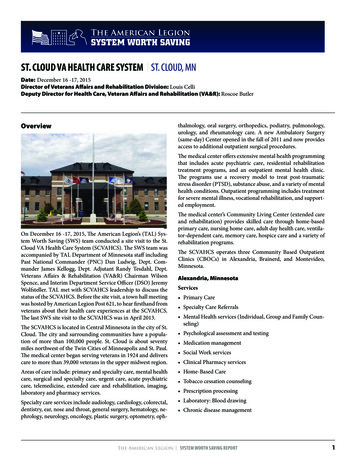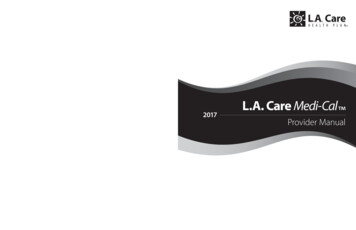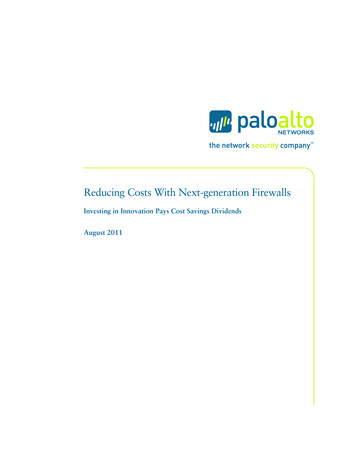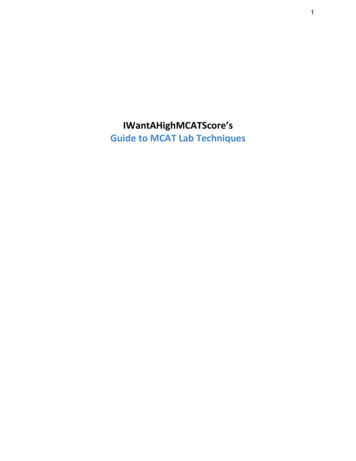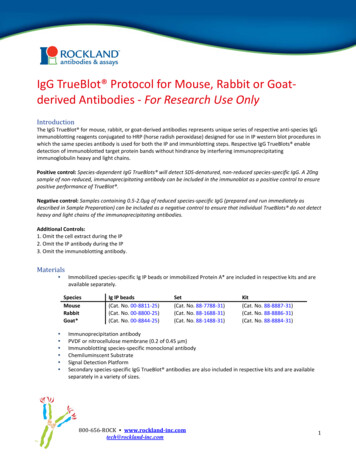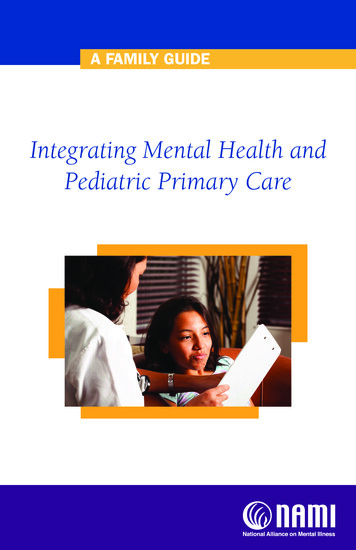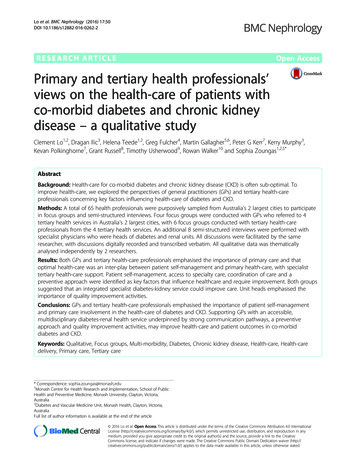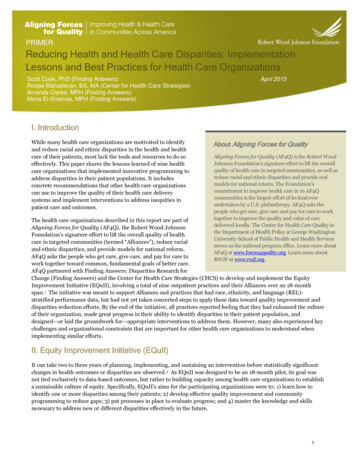
Transcription
PRIMERReducing Health and Health Care Disparities: ImplementationLessons and Best Practices for Health Care OrganizationsScott Cook, PhD (Finding Answers)Roopa Mahadevan, BS, MA (Center for Health Care Strategies)Amanda Clarke, MPH (Finding Answers)Mona El-Shamaa, MPH (Finding Answers)April 2015I. IntroductionWhile many health care organizations are motivated to identifyand reduce racial and ethnic disparities in the health and healthcare of their patients, most lack the tools and resources to do soeffectively. This paper shares the lessons learned of nine healthcare organizations that implemented innovative programming toaddress disparities in their patient populations. It includesconcrete recommendations that other health care organizationscan use to improve the quality of their health care deliverysystems and implement interventions to address inequities inpatient care and outcomes.About Aligning Forces for QualityAligning Forces for Quality (AF4Q) is the Robert WoodJohnson Foundation’s signature effort to lift the overallquality of health care in targeted communities, as well asreduce racial and ethnic disparities and provide realmodels for national reform. The Foundation’scommitment to improve health care in 16 AF4Qcommunities is the largest effort of its kind everundertaken by a U.S. philanthropy. AF4Q asks thepeople who get care, give care and pay for care to worktogether to improve the quality and value of caredelivered locally. The Center for Health Care Quality inthe Department of Health Policy at George WashingtonUniversity School of Public Health and Health Servicesserves as the national program office. Learn more aboutAF4Q at www.forces4quality.org. Learn more aboutRWJF at www.rwjf.org.The health care organizations described in this report are part ofAligning Forces for Quality (AF4Q), the Robert Wood JohnsonFoundation’s signature effort to lift the overall quality of healthcare in targeted communities (termed “Alliances”), reduce racialand ethnic disparities, and provide models for national reform.AF4Q asks the people who get care, give care, and pay for care towork together toward common, fundamental goals of better care.[In paAF4Q partnered with Finding Answers: Disparities Research forChange (Finding Answers) and the Center for Health Care Strategies (CHCS) to develop and implement the EquityImprovement Initiative (EQuII), involving a total of nine outpatient practices and their Alliances over an 18-monthspan.1 The initiative was meant to support Alliances and practices that had race, ethnicity, and language (REL)stratified performance data, but had not yet taken concerted steps to apply these data toward quality improvement anddisparities reduction efforts. By the end of the initiative, all practices reported feeling that they had enhanced the cultureof their organization, made great progress in their ability to identify disparities in their patient population, anddesigned—or laid the groundwork for—appropriate interventions to address them. However, many also experienced keychallenges and organizational constraints that are important for other health care organizations to understand whenimplementing similar efforts.II. Equity Improvement Initiative (EQuII)It can take two to three years of planning, implementing, and sustaining an intervention before statistically significantchanges in health outcomes or disparities are observed.2 As EQuII was designed to be an 18-month pilot, its goal wasnot tied exclusively to data-based outcomes, but rather to building capacity among health care organizations to establisha sustainable culture of equity. Specifically, EQuII’s aims for the participating organizations were to: 1) learn how toidentify one or more disparities among their patients; 2) develop effective quality improvement and communityprogramming to reduce gaps; 3) put processes in place to evaluate progress; and 4) master the knowledge and skillsnecessary to address new or different disparities effectively in the future.1
Finding Answers and CHCS facilitated this learning process by using an evidence-based framework called The Roadmapto Reduce Disparities (the Roadmap). The Roadmap (see Exhibit A for a high-level summary) is based upon findingsfrom systematic reviews of the disparities reduction literature and experiences of a wide variety of health careorganizations that have addressed disparities in their patient population.3 The primary goal of the Roadmap is toprovide health care organizations guidance and a process to follow to avoid key strategy and implementation errorswhen using their standard quality improvement approach for equity work. The Roadmap is designed to helporganizations integrate disparities reduction into all health care delivery efforts and encourages them to implementequity-focused quality improvement programs simultaneously or in parallel with other high-priority qualityimprovement activities. However, it is neither a strict checklist nor a set of steps to be implemented in a prescribedorder. The Roadmap is meant to be used flexibly, based on available resources, and adapted as needed for specificinterventions or broader capacity building.In addition to educational and coaching webinars to teach the Roadmap, Finding Answers and CHCS provided technicalassistance over the course of 18 months to facilitate practice implementation, including: Webinars on analysis, interpretation, and communication of REL-stratified quality data;Monthly calls to monitor progress and troubleshoot issues related to intervention planning andimplementation;Development of tools and resources to address specific concerns and build the practices’ skills in requestedcontent areas (e.g., data interpretation, community engagement, patient surveys); andIn-person meetings to facilitate in-depth technical assistance and peer learning.Practice project teams included a mix of frontline staff from quality improvement, care management, and patientengagement, as well as key leadership (e.g., chief medical officer, director of operations, and office manager). FindingAnswers and CHCS regularly engaged the practices’ regional Alliances as well to maximize their contributions asconveners and resources for change in the local AF4Q community. Engaging the Alliances was also intended to supportfuture sustainability and spread of the practices’ experiences to other health care organizations in the region.2
Exhibit AFromFinding Answers:Disparities Research for ChangeThe Roadmap toReduce DisparitiesImplementChangeSTEPA G U I D E F O R H E A LT H C A R E O R G A N I Z AT I O N S6STEPMeasure change. You’ll needevidence that you have made adifference. Create a timeline forevaluation and measurement.1LinkQuality& EquityStart small. Small changes helpbuild momentum. Look forlow-hanging fruit.Equity is intrinsic to quality improvement.Even when access to care is equal, racialand ethnic minority patients tend toreceive lower-quality care than Whites.Even when health outcomes improveacross the entire patient population,disparities between racial/ethnic groupscan remain or even worsen.Be adaptable. Strike a balancebetween adhering to your planand adapting it as needed.Equity improvement is acontinuous process.STEP5Buy-in is a commitment demonstratedthrough action. You are more likely tosucceed if you have the concretesupport of all stakeholders. Bespecific in what you ask andwalk away with a pledge.Create aCultureof EquitySTEP2It’s not enough for people toknow that disparities are aproblem; they need to recognizethat disparities exist amongtheir own patients and takeresponsibility for addressingthose disparities. That’s thebeginning of all equity eBuy-inDesigning an equityprogram requires creativityand innovation. It meanslinking what you havelearned in a root causeanalysis to your institutionalresources. There is nosingle right answer!DesigntheActivityIt’s important to understandwhy disparities exist and determinewhich causes of disparities can betackled. Consider the issues relevantto your patient population that mightcontribute to differences in care andoutcomes. Assemble a team thatincludes patients, institutional leadersand frontline staff to conduct aroot-cause analysis. Also make sureto recognize and support equitychampions in your organization.DIAGNOSEThe Roadmap’s six-step frameworkhelps integrate reducing disparities intoall health care quality improvementefforts. It is designed to be flexible:organizations can get on the road wherethey need to. Its goal is to support athoughtful and comprehensive approachto achieving equity, even though thecauses of disparities may vary acrossregions or patient populations.The Roadmap draws upon lessonslearned from Finding Answers’ 33grantee projects and 11 systematicreviews of the ties.orgDESIGNSECUREIMPLEMENT3
EQuII OrganizationsNine outpatient practices from a total of four Alliances participated in EQuII. The practices varied in structure, size, and patient population, but all had a mission tocare for the underserved. Exhibit B highlights key characteristics of each of the nine health care organizations, including: organizational type; location; populationsand conditions of focus for the initiative; data used to identify or further understand the disparity; interventions developed; and impacts of their efforts.Exhibit BHealth Care Organizations that Participated in EQuIIPractice(AF4Q Alliance)Crossroad Health Center(Cincinnati)Type andLocationFaith-based FederallyQualified HealthCenter in Cincinnati,OHThe HealthCareConnection(Cincinnati)Community HealthCenter in northernCincinnati, OH (firstcommunity healthcenter in Ohio)UC Health Primary Care atForest Park(Cincinnati)Family medicine andresidency practices innorthern Cincinnati,OH, affiliated withUniversity ofCincinnati HealthSystemFocus Population(s)and/or Condition(s)Hispanic/Latino patients,DiabetesAfrican American patients,Cervical CancerMinority patients, Medicaidpatients, DiabetesData Tracking andInformation Gathering Diabetes performancestratified by race/ethnicity Questionnaire to elicitpatient satisfaction withdiabetes program Cervical cancer screeningdata stratified byrace/ethnicity Survey of AfricanAmerican patients abouttheir perspectives, beliefs,and knowledge regardingcervical cancer screening Diabetes performancedata, stratified byMedicaid insurance status Focus group amongdiabetics with Medicaidinsurance statusEquity Interventions Diabetes education program for allpatients with A1C levels 9. Diabeteseducator worked closely withvolunteer RN to provide culturallytailored education to Hispanicpatients Utilization of Pre-Med bilingualstudents as patient “navigators” Developed strategies to increasepreventive education andappointments for cervical cancerscreening among African Americanpatients Conducted first-ever focus group withpatients Created changes in datainfrastructure to be able to analyzedisparities by diagnoses andinsurance statusOutcomes and Sustained Efforts Improved diabetes performance amongHispanic patients, and overall Increase from 40% to 54% in proportionof Hispanic patients with HbA1c 8(positive outcome) Reduction from 30% to 18% inproportion with HbA1c 9 (positiveoutcome) Increase from 7% to 14% in D5 OptimalDiabetes Care rate across overall patientpopulation Enhanced use of stratifiedrace/ethnicity performance data andpopulation health data managementsystem to identify disparities Better understanding of the drivers ofdisparity (e.g., perceived economicburden) in cervical cancer screeningamong African American patients Vision for how to integrate equity effortsinto broader practice workflow and staffdevelopment, particularly given influxof new patients with Medicaidexpansion Better understanding of the selfmanagement barriers (e.g., access toaffordable healthy food and exercise)facing Medicaid patients with diabetes Ability to look at disparities byinsurance status, in addition torace/ethnicity Enhanced data management skills andunderstanding of disparities-focusedquality improvement among staff4
Practice(AF4Q Alliance)Swope Health Services(Kansas City)Elmwood Health Center(Western New York)Jericho Road CommunityHealth Center(Western New York)Type andLocationPrimary Care andCommunity MentalHealth Center inKansas City, MOCommunity basedhealth center inBuffalo, NY, that servesas a generalambulatory center andspecialized source ofcare for individualswith developmentaldisabilitiesFaith-basedCommunity PrimaryCare Health Center inNiagara area, NY, thatmerged with JerichoMinistries to providemedical andnonmedical services toprovide morecomprehensive careFocus Population(s)and/or Condition(s)African American patients,Co-morbid diabetes andSerious mental illness (SMI)Minority patients, Low-incomepatients, DiabetesData Tracking andInformation Gathering Health home enrollmentdata, including patientdiagnosis/co-morbidityand race/ethnicity Diabetes performancedata, stratified byrace/ethnicity Focus groups amongpatients with diabetesSomali immigrant patients,Diabetes Focus groups amongSomali-speakingcommunity health workers Focus Groups amongSomali patients withdiabetes Ongoing questionnairesand patient satisfactionsurveys to assessappropriateness ofphysical activity classes Pre- and post-interventionevaluations to measurehealth outcomes related todiabetesEquity InterventionsOutcomes and Sustained Efforts Focused on the needs of AfricanAmerican patients served by a healthhome to coordinate physical andbehavioral health care Proposed incorporation of equity inthe organizational mission statement Developed a cultural competencycommittee to focus on equity-relatedareas of improvement across theorganization Enhanced triage coordination tomaximize services of carecoordinator, diabetes educator, andnurse care manager Psycho-educational support groups Better understanding of the importanceof personal staff connections withpatients Learned how to “go beyond” data inidentifying and understandingdisparities Created a conceptual framework foraddressing racial/ethnic disparities inongoing quality improvement Exercise class conducted by YMCAstaff located at Jericho Road HealthCenter Better engagement with Somali patientsand larger community Better utilization of skills of Somalispeaking community health workers/interpreters in quality improvementefforts Development of community partnershipwith the local YMCA National connections with otherpractices focused on Somali populations5
Practice(AF4Q Alliance)Mount St. Mary’sNeighborhood HealthCenter(Western New York)Type andLocationFaith-basedCommunity PrimaryCare Health Center inLewiston, NYMonroe Clinic(Wisconsin)Multi-specialty Clinicand Hospital inMonroe, WI.Wheaton Franciscan(Wisconsin)Integrated healthsystem based inGlendale, WI (largerMilwaukee area), with70 primary care sitesand 15 hospitals inWisconsin, Illinois,and IowaFocus Population(s)and/or Condition(s)Hispanic/Latino patients,DiabetesSpanish-speaking patientsAfrican American patients,DiabetesData Tracking andInformation Gathering Diabetes performancedata, stratified byrace/ethnicity Patient interviews withHispanic patients withdiabetes, conducted bySpanish-speakingphysician Used Community AdvisoryCouncils to collectqualitative data on patientand community needs,revealing obesity andbinge drinking as highpriority issues Diagnosis data across localclinic sites, stratified byrace and ethnicity Focus groups, AfricanAmerican patients withdiabetesEquity Interventions Forms in Spanish for all Spanishspeakers, including those w/odiabetes Medication instructions and patienteducation materials printed inSpanish Automatic appt. reminder calls inSpanish Customized EHR (E-Clinical Works)to ensure all electroniccommunications (e.g., outgoing calls)are in Spanish Purchased of educational materials(DVDs) in Spanish, in collaborationwith the American DiabetesAssociation Care coordinatortranslated/disseminated SpanishmaterialsOutcomes and Sustained Efforts Enhanced services, communications,and customization for the needs ofHispanic patients, especially those withdiabetes Increase in number of Hispanic patientsutilizing practice services, and thesupport of a community health worker Standardized processes, includingstaff training, to ensure accurate andreliable collection of REL data. Made plans to diversify theracial/ethnic makeup of CommunityAdvisory Boards and Board ofDirectors. Created a language servicescoordinator position to meet growingneeds of non-English speakingpatients. Developed an understanding of how toaddress disparities through increasedcommunity engagement and use ofexisting resources in the face ofdisparities data with small sample sizes Provided community health workerservices for patients with diabetes toimprove self-management of thecondition. Developed a three-yearorganizational Diversity andInclusion strategic plan that includesimplementing strategies to reducehealth and health care disparitiesacross all sites of care Improved understanding of the care andbehavior change needs of AfricanAmericans with diabetes*For more information regarding the equity interventions at Jericho Road Community Health Center and Wheaton Franciscan, read the Robert Wood Johnson Foundation’s Quality fields Notes equity brief.*For more information regarding the equity interventions of Crossroad Health Center, read the center’s Quality fields Notes profile.6
III. Lessons LearnedThe following findings are from the experiences of the nine health care organizations that participated in EQuII, andwere compiled by Finding Answers and CHCS as technical assistance (TA) providers of the initiative. At the conclusionof the initiative, the TA providers conducted semi-structured interviews with each practice to gather criticalimplementation lessons, staff feedback on their particular experiences, and to make recommendations for otherorganizations that wish to carry out similar work. The lessons learned and best practices gathered are organized here bycomponents of Greenhalgh, et al.’s model Diffusion in Service Organizations.4 The model provides a conceptualframework useful for understanding the behaviors and routine ways of working that hinder or enhance theimplementation of innovations in health care service delivery organizations. For the purposes of this report, theRoadmap is the “innovation” that EQuII attempted to diffuse throughout the nine participating health careorganizations, summarized as identifying a disparity in the patient population, designing an intervention to reduce it,and implementing the intervention.While the Diffusion in Service Organizations model consists of several conceptual categories, this paper highlights fourthat were most salient to the experiences of the EQuII organizations:1.2.3.4.Attributes of the Innovation: Innovation-system fit, compatibility, and complexitySystem Antecedents for Innovation: Slack (available) resources and technical capacityAdoption by Individuals: Stakeholder concernsImplementation of the Innovation: Internal communication1. Attributes of the InnovationInnovation-System Fit: The more relevant the innovation is to the performance of the intended user’s work, themore likely it is to be successfully adopted and implemented, particularly if it improves task performance.The majority of the practices made a deliberate decision to look for disparities in health conditions that they had alreadyprioritized for quality improvement intervention. Crossroad Health Center further noted that participation in EQuIIwould help the practice comply with upcoming modifications of the Health Resources and Services Administration’s(HRSA’s) Uniform Data System reporting requirements to implement more nuanced health outcome and disparitiesmeasures. EQuII also aligned with their need to meet data-driven quality requirements to gain certification as a patientcentered medical home (PCMH) and further its goal of enhanced patient engagement given the recent addition of acertified diabetes educator and bilingual patient navigator. Practices that were Federally Qualified Health Centers(FQHCs) had similar rationales, as they were already required to submit race/ethnicity-stratified performance data toHRSA but in most cases had rarely analyzed and incorporated these data into quality improvement activities.Many practices also cited the capacity building they experienced to achieve PCMH Level III status as a helpful precursorto data-driven disparities work. Thus, practices without experience implementing a PCMH model might feel less skilledin implementing some Roadmap activities. The Roadmap strongly recommends actively engaging patients to elicit theirunderstanding of the identified disparity and engage their input in designing appropriate interventions. The PCMHmodel’s focus on population management, patient experience of care, data-informed quality improvement activities, andshared decision-making aligns with Roadmap recommendations. Thus, practices felt their PCMH implementationexperiences facilitated their EQUII work.Compatibility and Complexity: Practices are more likely to adopt an innovation when they believe it iscompatible with their values, norms, and perceived needs (high compatibility) and when they believe that adoptingthe innovation will be simple (low complexity).Compatibility. All of the practices began participation in EQuII with an existing commitment to disadvantagedpopulations. Several practices had terms such as “justice,” “access,” “discrimination,” and “racial equity” in their missionand vision statements. As many were publicly financed (e.g., FQHCs) or religiously affiliated, they also had more of acommunity, or service, orientation; FQHCs are required to have governing boards that include a majority (at least 51percent) of users of the health center who are representative of the populations served. The practices self-identified asholding specialized knowledge in understanding and serving their specific patient populations and surroundingcommunities with some track record for providing customized programs. However, their motivations to participate in7
EQuII also stemmed from the recognition that the status quo was not sufficient to take them to their highest operatingpotential. Organizations were also driven by the following business and efficiency rationales in addition to their mission:1) regulatory and payer-led incentives to improve quality and cost measures; 2) high, often unmanageable patient flow;and 3) a preponderance of racially and ethnically diverse patients, particularly among safety-net practices servingmajority-Medicaid, under-insured, or uninsured populations.(Misconceptions of) Complexity. A common challenge among the practices was accurately anticipating the level ofeffort, resources, and new skills that would be required to implement disparities-focused work. Practices discovered thatidentifying and reducing specific disparities, while related and beneficial to their existing programming, requiredsubstantially different skills, quality improvement activities, and ways of applying organizational resources compared toother initiatives. The hurdles were varied, but common ones included: 1) gaining broader staff buy-in beyond theexisting champions leading the work; 2) making the right kinds of demographic and performance data queries andwaiting for these data to be extracted or analyzed appropriately; 3) knowing where to turn when patterns in thedisparities data did not point to easy next steps; 4) engaging patients and community members; and 5) staff turnover.Practices came to realize by the end of the EQuII that simply “knowing” from a conceptual standpoint or having theright philosophical frame was not enough to successfully pursue their equity activities. One practice representativestated, “We think about it [disparities], but did not have the [correct] processes in place. We thought we were alreadydoing everything we could. We were wrong.” Another practice representative noted, “It’s so much more involved than Iwould have thought. I’m not so naïve anymore.”2. System Antecedents for InnovationSlack (Available) Resources: Organizations with resources beyond the minimum required to maintain currentoperations (i.e., slack resources) are more likely to adopt and implement innovations.Nearly every practice that participated in EQuII struggled with adequately resourcing its disparities reduction efforts,particularly in terms of personnel. Approximately half of the participating organizations experienced significantturnover and staff transitions in key leadership and implementation positions over the course of the initiative, which ledto significant interruptions and periods of inactivity. Several factors likely played a role, including an overall weakeconomy (the Great Recession), and multiple changes in the health care policy and finance environment that led tostaffing disruptions and organizational facelifts (e.g., mergers, ACO transformation, and electronic medical record[EMR] implementation). Further, the vast majority of the practices’ resources, particularly in the case of safety netpractices, were already being used for other activities, with the organizations operating on thin financial margins.While staff transitions can seem inevitable, practices identified some long-term solutions that could strengthenpersonnel capacity and institutional knowledge to sustain equity efforts in the face of staff discontinuity. These solutionsinclude identifying and empowering multiple staff members to implement equity activities; automating recurring taskswhenever possible (e.g., using population health management software to routinely produce REL-stratified performancereports); and regularly communicating about disparities issues and activities with all staff. The Roadmap also suggestscross-training staff; documenting institutional knowledge; incorporating intervention training into staff orientation andrefresher courses, including program responsibilities in job descriptions; and assessing job candidates’ interest incurrent and future disparities reduction activities. The latter is especially important for job candidates seekingleadership positions.Technical Capacity: Innovations perceived by key players as simpler to use are more easily adopted.EMR data extraction. All of the practices used EMRs and collected patient-level race and ethnicity data before theirparticipation in EQuII; some also collected patient’s preferred language. However, many of the organizations beganEQuII with the misperception that their EMR would allow them to somewhat easily generate reports on key health careprocess and outcome measures, stratified by patient demographics. When they attempted to generate the desiredreports, they experienced many unanticipated EMR-related challenges. Despite the complexity, which posed the dangerat times of “stalling” progress, practices were able to develop alternative means of accessing some of the desiredinformation to maintain momentum, such as: manual extraction for a smaller sample set of data; data manipulation8
outside of the EMR system; having IT staff develop software workarounds; and collecting qualitative data from patientson their perceived disparities as an alternative to quantitative data.Quality of demographic data. Some of the practices that did succeed in generating stratified quality reportsdiscovered new concerns about the quality of the data, such as large percentages of the patient population with“unknown” or “refused” race, combinations of “race” and “ethnicity” that suggested patient misunderstanding of thecategories, and unexpectedly large percentages of missing data. These were attributed to inadequate data collection andrecording procedures, such as lack of consistency across staff regarding where specific quality data should be enteredinto the EMR, lack of clarity on the order and definitions of the race and ethnicity categories, and hesitation about howto coach patients on the data intake process. During the course of the initiative, at least three practices implemented, ormade plans to implement, refresher training on best practices for collecting and entering patient-level race, ethnicity,and preferred language data for frontline reception staff.Data analysis and interpretation. A related challenge was lack of staff with the expertise in data management andstatistical analysis to interpret data reports. Staff were not always familiar with how to query their EMRs effectively toproduce the right reports, nor how to use analytic software (e.g., Excel, SPSS, and in-built features of EMRs) to calculateappropriate rates. Common issues included the inability to display the demographically stratified data in a meaningfulway (e.g., charts or graphs), identify the appropriate numerators and denominators to construct measure rates, comparerates appropriately within and across groups, and decide if a difference in rates was meaningful. EQuII TA providershelped conduct specific analyses and provided data templates as necessary to address these gaps in staff knowledge. TAproviders also consulted with AF4Q Alliances to see what kinds of local resources (e.g., university partners or dataworkgroups) might assist staff with building that capacity. Having identified the need for this capacity, some practices,such as HealthCare Connection, decided to include these competencies in future job descriptions for staff members.Practices that could not access stratified data, or did not identify disparities in their available data, relied uponqualitative and population-level data to inform their decisions about which disparity to target. Both Elmwood HealthCenter and UC Forest Park used income data (e.g., insurance status) to identify gaps in care and outcomes, as theirrace/ethnicity st
people who get care, give care and pay for care to work together to improve the quality and value of care delivered locally. The Center for Health Care Quality in the Department of Health Policy at George Washington University School of Public Health and Health Services serves as the national program office. Learn more about AF4Q at


